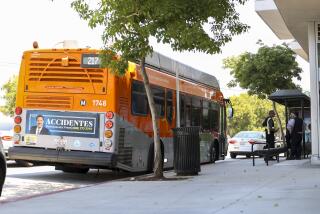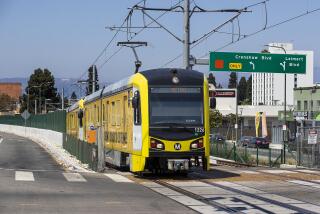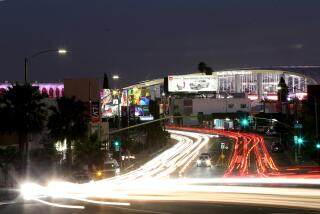Consider North-South Busway
- Share via
Gov. Gray Davis’ recent announcement that he supports $2.2 billion for transportation projects in the Los Angeles region over the next few years is an opportunity to develop long-term transportation solutions for Southern California, particularly the San Fernando Valley.
We in the Valley must recognize that we have lost millions of dollars for transportation projects in the past because of bureaucracy and a lack of consensus among residents and community leaders. We must further recognize that our current opportunity cannot be wasted and requires initiatives that are not only well-planned and cost-effective but also serve the entire population, particularly those most in need.
The governor’s plan identifies many projects, including new carpool lanes on Interstate 5 between the Ventura and Antelope Valley freeways, a new ramp at the San Diego / Ventura freeway interchange, a study of future projects along the Ventura freeway, funding to purchase new buses and $245 million for a new high-speed busway along the Burbank-Chandler railroad right of way from the North Hollywood Metro Red Line station to Warner Center in Woodland Hills.
The governor recognizes that to be successful these initiatives must build upon previous investments. That is why I believe he has included such programs as carpool lane expansions and improvements at the San Diego / Ventura freeway interchange--both initiatives I supported as chairman of the Los Angeles City Council Transportation Committee and as an alternate member of the Metropolitan Transportation Authority board.
But although we desperately need funding for our bus system, which has been underserved by the MTA for years, I question whether the proposed Burbank-Chandler route would make the best use of that money.
The use of the Burbank-Chandler corridor has been debated for years. It runs past predominately single-family homes and a pedestrian-oriented, Orthodox Jewish community that strongly opposes a busway. In the 1980s, the state Legislature passed a measure limiting transportation options along this corridor to a subway to protect these neighborhoods. I am not saying that a subway is the right solution for the Valley; I am saying that we need to make sure that a busway along the Burbank-Chandler route is appropriate when we consider spending hundreds of millions of dollars.
Why not consider a dedicated busway running north-south along Van Nuys Boulevard instead? The northeast Valley has one of Los Angeles’ highest concentrations of people who use public transportation. The MTA has seven bus lines that run on Van Nuys Boulevard, compared to just one line on Chandler. Without strong links to the northeast Valley, any busway proposal will lack riders and will fail to serve those most in need.
Other east-west busway routes must also be considered, including expanded service along Sherman Way and Roscoe and Victory boulevards. Each of these streets crosses the entire Valley from east to west but, unlike the Burbank-Chandler route, does not go entirely through residential areas. However, the appropriate mix of businesses, homes and apartments are all nearby, providing many people access to their homes and jobs.
*
Los Angeles County Supervisor Zev Yaroslavsky and others have said a new busway--whether built on the Burbank-Chandler right of way or someplace else--could be modeled after Curitiba, Brazil’s transportation system. Curitiba has approximately 2 million residents. Its transportation system has been hailed by environmentalists, economists and transportation experts around the world. The system uses more than 1,100 buses to make 12,500 trips each day and serves approximately 1.3 million passengers.
But the main reason the Curitiba system is successful is because it was planned. It consists not of stand-alone routes but is carefully integrated with urban development. This is what the Valley needs. Building one busway across residential neighborhoods is not enough. We need multiple routes strategically designed to serve the most people.
Earlier this month, a new board was formed to determine whether the Valley should have its own transit zone, a process I put into motion in 1997. Now it’s time to go further, while we have an opportunity to obtain state funds. If the new transit zone board, community leaders, elected officials, the MTA, the state Department of Transportation and Caltrans all work together, the Valley can create a workable system that will serve everyone. Let’s not let this opportunity slip away--again.
More to Read
Sign up for Essential California
The most important California stories and recommendations in your inbox every morning.
You may occasionally receive promotional content from the Los Angeles Times.










